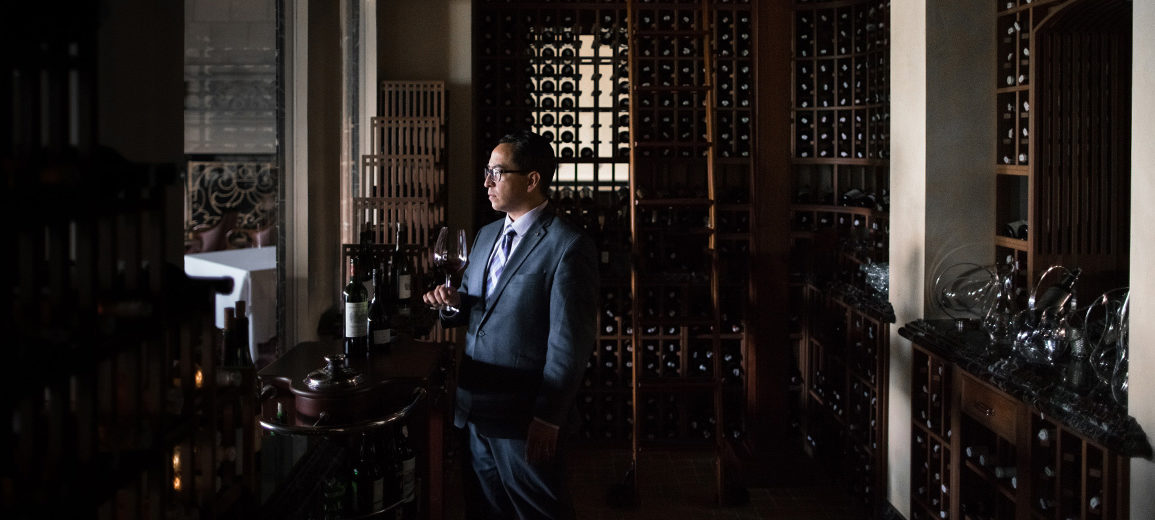A certified sommelier, Rafael Sanchez has over a decade of experience in the food and wine industry. A taste of a 1945 Coeval Blanc, while working as a server assistant at The Raymond Restaurant in Pasadena, led him to pursue a career in wine; and where he eventually worked his way up to beverage director by the age of 23. In 2013, Sanchez joined the Addison team as captain, where he began to learn the elements that make up a five star restaurant. Now as wine director, he plans to maintain the restaurant’s long-time focus on classic regions and producers while also emphasizing smaller producers from lesser known regions, including the local wines of San Diego.
Congratulations on your recent appointment as Wine Director at Addison. From cult California vintages and New World discoveries to distinctive European varietals, what are some unique challenges of staying on top of such a large, diverse list?
Thank you. It is a real honor to be a part of the team behind such an acclaimed restaurant, now celebrating its tenth year. We’re always striving to maintain balance in Addison’s wine list. We look to source not just newly released wines, but also well-stored older vintages to provide a variety of wines on our list. So, you’ll find some bottles that are best enjoyed in a youthful stage, and others—likely from classic wine regions— that need at least a few years to shine. It paves the way for a greater degree of creativity from our wine team with respect to wine pairings.
Are there any offerings that might surprise a guest when they settle down to look at your list?
We are very excited about Madeira and the wines from South Africa. We’ve been featuring a dry Chenin Blanc [from South Africa] on the tasting menu and guests frequently remark that they have never experienced a wine with that kind of texture and richness. You don’t typically look towards South Africa for a wine in that style!
The Madeiras are great because we offer some older vintages dating back to 1865, the year marking the end of the American Civil War. With this collection of older vintages, guests often select a year special to them, be it for a birthday or anniversary.
How did you fall in love with wine?
I fell in love with wine completely by accident. While bartending at my first restaurant job in Pasadena, I was handed a glass with a few ounces of a wine. The sommelier asked me to set it aside so we could try it after service. I gave it a smell and I was struck at how rich and seductive the nose was, almost like a bowl of dark chocolate covered berries. After the service, having forgotten about the wine, the sommelier pulled the glass out and I smelled it again. This time around, it was much more savory with notes of mint and eucalyptus. The wine had completely changed. Turned out it was a 1945 Cheval Blanc. From then on, I was hooked.

What is your opinion on the 100-point system?
The 100-point system helps a lot of people break into the wine world as consumers. And I can appreciate that! Where it gets a little tricky is assuming “points” equals “pleasure.” For example, rosé wines typically don’t get rated; and if they do, they might receive 89-91 points. But, one could argue that rosés are the most pleasurable wines you could buy. For me, a perfect wine is the right wine with the right food, with the right people.
What are your favorite American wines to serve to fellow sommeliers?
There are a number of smaller, quality-driven producers like Arnot-Roberts making great wines (Pinot Noir, Zinfandel, Cabernet Sauvignon) from all over California that are very interesting. Older vintages of Littorai are tremendous, as are the always fresh and bright white wines from Tatomer. I think pouring Schramsberg’s Pinot Noir driven “Reserve” sparkling wine always raises eyebrows. People always think it’s Champagne with it’s richer profile.
Have you ever had a life-changing wine moment?
That 1945 Cheval Blanc changed everything. But I really got immersed in wine when I worked for James Suckling. Traveling and tasting with him was a true privilege. In the same day, we would taste Barolo from barrel, followed by new releases at lunch, and finish with 50-year-old Barolo for dinner. Being able to experience the wine in those three stages in the same day was mind-blowing. Another great wine moment: In 2012, I was in Champagne, France for the Terre et Vins tasting. I was invited to a special dinner with all of the producers. It was in Jean-Baptiste’s (from Champagne Geoffroy) barn in Cumieres. All the producers brought still wines, Champagnes, and Marc that is usually reserved for their own consumption. Pascal Doquet brought 15-year-old still white wine from Le Mesnil, and that was just to start. Being with the producers in that humble barn, eating sausage and potatoes, and drinking their wines was sublime.
What do you see as important trends—good or not so good—in our evolving culture of restaurants, food and wine?
We’ve noticed that guests are much more informed than, say, five years ago. Definitely a good thing! It pushes us sommeliers to stay on top of our programs and challenges us to find new ways to peak the interest of our guests. We’re also noticing how regions and grape varietals tend to get generalized. For example: “Rieslings are sweet” or “California Chardonnay is buttery” or “French wine is too austere.” This is why at Addison we are big fans of pairing chef William’s tasting menus with wines. We are passionate and excited about pouring wines that guests wouldn’t generally choose on their own, which ultimately enhances the dining experience. It’s important to keep an open mind with wine; you never know what will surprise you.
Join the Premier Network of Worldwide Wine Professionals & create a SOMM’S LIST profile today.


